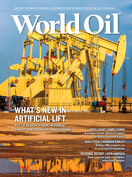Issue: May 2015
Special Focus
Part 1: In this first of two monthly reports, the authors highlight innovations in beam/rod pumping, linear lift units, hydraulic piston pumps, hydraulic jet pumps, and more.
Features
The North Sea’s Troll field, 80 km northwest of Bergen, is Norway’s largest gas reservoir.
A wireless seismic system offers a more efficient way to acquire data in challenging terrain. The system proved its capabilities on a record-breaking survey in Iraqi Kurdistan, facilitating seismic acquisition, despite a regional earthquake and armed conflict between the Kurds and ISIS.
Drilling, LNG prospects face stiff headwinds
Responding to falling oil prices, some Latin American governments push energy investment, while others slash E&P budgets.
Alvaro Teixeira is a civil engineer and geologist who worked 36 years for Petrobras on E&P projects in Brazil and abroad.
Mexico is the world’s 10th largest oil producer and has some of the largest reserves in the Western Hemisphere.
Statoil Brazil, in partnership with China’s Sinochem, is betting $3.5 billion in the Campos basin. Statoil Brazil president Pål Eitrheim explained the company’s strategy to World Oil.
Organizations in academia and industry support the development of new geological information tools to help geoscientists sift through huge quantities of data, and incorporate that data seamlessly into their workflow, leading to improved decision making and improving the odds of exploration success.
Columns
Climbing up the down cycle
Vexing questions
Modern oil and gas exploration is good for the environment: Fact
Turn out the lights
Alaska oil money, onshore and off
Five years after Macondo, the industry is better prepared to respond
Despite lower crude prices, India’s ONGC goes ahead with ambitious plans
Why I am a NOMAD
Alexander Palynchuk: A lifetime of innovation
PESA’s non-industry speakers make excellent points
News & Resources
World of oil and gas
Industry at a glance
People in the industry
New products and services
Companies in the news
ShaleTech Report
It has now been 21 years since I attended the very first NAPE expo, a marketplace for buying and selling oil and gas prospects and producing properties.
A data-driven, neural network model was developed to quickly and economically evaluate completion effectiveness for Marcellus shale wells. This model was used to identify significant opportunity to improve production for new wells by modifying completion and frac design. According to the model, geology and reservoir quality dominate Marcellus production. However, controllable contact and conductivity-related parameters are also significant. The number of frac treatments and the amount of proppant used in the completion rank first and second in significance. This is followed by perforation design, fluid volume and treatment rate.
The Class 1 railroads are back in the U.S. crude oil business. Now, the hard part.
Perhaps the most significant, extensive changes in crude-by-rail transportation were made on May 1, 2015, by the U.S. Department of Transportation (DOT) and its agencies, the Federal Railroad Administration (FRA) and Pipeline and Hazardous Materials Safety Administration (PHMSA). The changes are contained in a “final rule” for “the safe transportation of flammable liquids by rail.”
Starting with nine wells and ending with a $1.3-billion sale, the systematic application of engineering principles, guided by geologic analysis, creates success in North Dakota.
Fracturing efficiency gains enabled Nexen to optimize its operations, and maximize its profits, in Canada’s Horn River basin. Logistical preparations for the remote nature of the site, an emphasis on the use of produced water, and switching to bi-fuel pumps resulted in significant operational savings.



